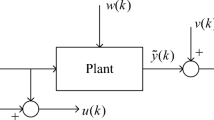Abstract
The bias eliminated least squares (BELS) method, which is known as efficient for unknown parameter estimation of transfer function in the correlated noise case, has been developed and applied effectively to the closed-loop system identification. In this paper, under the general settings, the realizations of the BELS method as a weighted instrumental variables (WIV) method in both direct and indirect closed-loop system identification are established through constructing an appropriate weighting matrix in the WIV method. The constructed structures are similar in both cases, which reveals that all the proof procedures of the two realizations are the same. Thus, the unified realizations of the BELS as the WIV method for the closed-loop system identification can be built. A simulation example is given to validate our theoretical analysis.
Similar content being viewed by others
References
Ljung L. System Identification: Theory for the User. Englewwod Cliffs, NJ: Prentice-Hall, 1987
Söderström T, Stoica P. System Identification. Hemel Hempstead, UK: Prentice-Hall, 1989
Van den Hof P. Closed-loop issues in system identification. In: Proc. of the 11th IFAC Symposium on System Identification. 1997, 4: 1651–1664
Van den Hof P, Schrama RJP. Identification and Control—closed-Loop Issues. Automatic, 1995, 31(12): 1751–1770
Forssell U, Ljung L. Closed-loop identification revisited. Automatic, 1999, 35(7): 1215–1241
Söderström T, Stoica P. Instrumental variable methods for system identification. Lecture Notes in Control and Information Sciences. Berlin: Springer-Verlag, 1983
Stoica P, Söderström T. Optimal instrumental-variable estimation and approximate implementation. IEEE Trans Autom Control, 1983, 28(7): 757–772
Stoica P, Söderström T. Optimal instrumental-variable methods for the identification of multivariable linear systems. Automatica, 1983, 19(4): 425–429
Gilson M, Garnier H, Young P, et al. A refined IV method for closed-loop system identification. In: 14th IFAC Symposium on System Identification. 2006. 903–908
Sagara S, Wada K. On-line modified least-squares parameter estimation on linear discrete dynamic systems. Int J Control, 1977, 25(3): 329–343
Feng C B, Zheng W X. Robust identification of stochastic linear systems with correlated output noise. IEE Proc-D, 1991, 138(5): 484–492
Zheng W X, Feng C B. A bias correction method for indirect identification of closed-loop systems. Automatica, 1995, 31(7): 1019–1024
Zheng W X. Identification of closed-loop systems with low-order controllers. Automatica, 1996, 32(12): 1753–1757
Zheng W X. Parametric identification of noisy closed-loop linear systems. In: IFAC 14th Triennial World Congress. 1999. 301–306
Zheng W X. An efficient approach to identification of feedback control systems. In: Proc. of the 3rd Asian Control Conference. July 4–7, 2000
Zheng W X. Parametric identification of linear systems operating under feedback control. IEEE Trans Circuits Syst, 2001, 48(4): 451–458
Zheng W X. A modified method for closed-loop identification of transfer function models. IEEE Trans Circuits Syst, 2002, 49(4): 556–562
Zheng W X. Application of BELS based methods in direct identification of linear systems from closed loop data. In: Proceedings of 42nd IEEE Conference on Decision and Control. New York: IEEE Press, 2003. 4539–4544
Jia L J, Hanada T, Jin C Z, et al. On the relation between BELS and IV methods. In: Proc. of 41st IEEE Conference on Decision and Control. New York: IEEE Press, 2002. 3440–3445
Gilson M, Van den Hof P. On the relation between a bias-eliminated least-squares (BELS) and an IV estimator in closed-loop identification. Automatica, 2001, 37(10): 1593–1600
Gilson M, Van den Hof P. IV methods for closed-loop identification. Automatica, 2005, 41(2): 241–249
Author information
Authors and Affiliations
Additional information
Supported by the National Natural Science Foundation of China for Distinguished Young Scholars (Grant No. 60625104), the Ministerial Foundation of China (Grant No. A2220060039), and the Fundamental Research Foundation of BIT (Grant No. 1010050320810)
Rights and permissions
About this article
Cite this article
Jia, L., Tao, R., Wang, Y. et al. Realizations of BELS as WIV method in both direct and indirect closed-loop system identification. Sci. China Ser. F-Inf. Sci. 52, 712–722 (2009). https://doi.org/10.1007/s11432-009-0049-1
Received:
Accepted:
Published:
Issue Date:
DOI: https://doi.org/10.1007/s11432-009-0049-1




